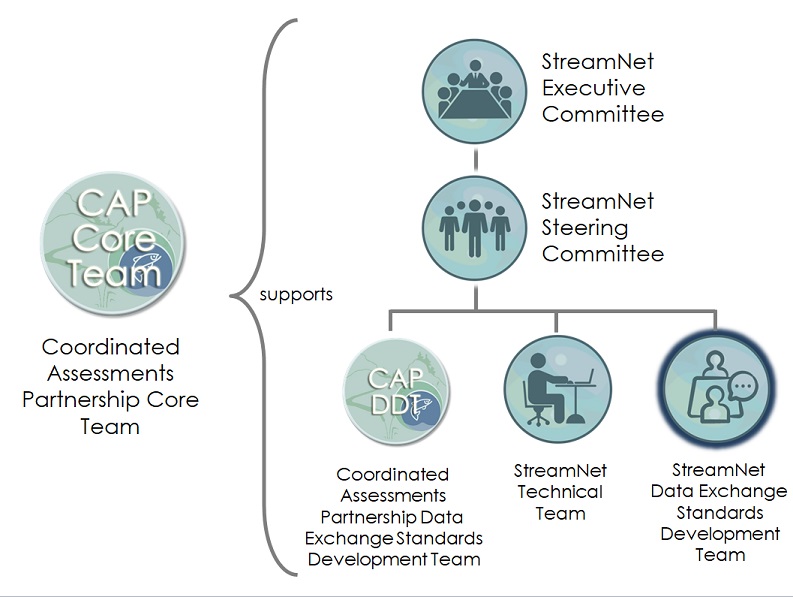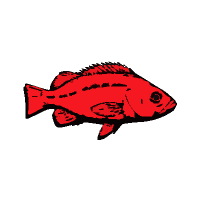StreamNet DES Development Team
Purpose
The StreamNet DES Development Team (SN DDT) creates the data-sharing rules for Fish Monitoring Data and documents the rules in the StreamNet Data Exchange Standard (DES). A DES is a set of formal rules for the meaning and structure of shared data. These rules are agreements among partners on the definition, structure, manipulation, and management of shared data. The Fish Monitoring Data system receives and houses standardized fish monitoring time series data sets and makes them publicly available through online query tools. The source data come from the multiple state, tribal, federal, and other StreamNet partners’ data management systems and are converted by the data owners to the DES standards for sharing via StreamNet.
Goals and Objectives
The SN DDT’s goal is to improve the quality of fish data obtained from StreamNet, facilitating assessments and reporting for fisheries mitigation, recovery, and management. To achieve this goal, the SN DDT develops trends DESs and collaborates with the StreamNet Executive Committee (SN ExCom) and StreamNet Technical Team (SN TT) to determine how these data should be presented and made available via online query systems. More specifically, the SN DDT:
- Adds DESs for new StreamNet Fish Monitoring Data categories and for other data categories as needed
- Refines existing DESs to improve the quality of data accessed
- Implements DES additions and changes in a manner that considers efficiency for data providers and StreamNet staff and utility for data end users
- Reduces duplication of effort by data providers by leveraging content from other regional data systems to provide metadata and other supporting content for submitted data
- Achieves efficiencies in data flow processes from partners’ data management systems to the StreamNet trends database
Background
The SN DDT was formed in 2021. This team took over the DES development tasks for trends that were previously assigned to the StreamNet Technical Team.
Creation of the new SN DDT was implemented to clarify roles and responsibilities and to mirror the structure of the CAP DDT.


Relationship with Other Teams and Committees
The SN DDT is guided by the SN SC, the Five-Year Plan for the Coordinated Assessments Partnership, the StreamNet Strategic Plan, and StreamNet’s annual work plans.
Meetings
The chair and co-chair keep SN DDT members informed of meeting dates, agendas, and notes. Meeting agenda topics can be submitted to the chair or co-chair.
Members and Chair
The SN DDT consists of biologists, data management, and IT technical staff from the federal, tribal, state, and regional organizations submitting and consuming data. Most member organizations have more than one individual participating on the SN DDT who contribute to discussions, product development, and decisions.
The SN DDT is organized and facilitated by Pacific States Marine Fisheries Commission (PSMFC) StreamNet staff, with the PSMFC StreamNet Regional Fishery Biologist / Database Administrator serving as chair. The StreamNet Program Manager participates as needed to provide contextual input from the StreamNet Strategic Plan, the SN ExCom, and the StreamNet Steering Committee (SN SC).
Current Members
- Mike Banach (Chair; PSMFC-StreamNet)
- Greg Wilke (PSMFC-StreamNet)
- Van Hare (PSMFC-GIS Center)
- John Arterburn (Colville Tribes)
- George Batten (Environmental Science Associates, assisting Colville Tribes)
- Denise Kelsey (CRITFC)
- Tami Wilkerson (CRITFC Columbia Basin Fish & Wildlife Library)
- Evan Brown (IDFG)
- Chris Harrington (IDFG)
- Randy Walsh (IDFG)
- Bekki Waskovitch (IDFG)
- Ace Riverman (MFWP)
- Kasey Bliesner (ODFW)
- Jon Bowers (ODFW)
- Jake Chambers (ODFW)
- Nadine Craft (ODFW)
- Peter Robinson (ODFW)
- Todd Gilmore (USFWS)
- David Hines (USFWS)
- Michelle Groesbeck (WDFW)
- Leslie Sikora (WDFW)
- Michelle Steg (YN)
Currently there are no members identified for CTUIR, CTWSRO, NPT, and SBT.
Team Documents
| File | Description | File Date |
|---|---|---|
| Data Exchange Standard Development and Revision Procedures | Describes process followed when creating a new data exchange standard (DES) or when revising an existing DES used for exchanging standardized data with StreamNet’s fish monitoring data (“trends”) and with Coordinated Assessments Partnership’s fish high level indicators data systems. | 2021 |
| StreamNet Data Categories Maintained in 2014 | 2014 | |
| Five-Year Plan for the Coordinated Assessments Partnership (v. 20200902) | Sep 2, 2020 Executive Committee Meeting – Five-Year Plan for Coordinated Assessments Partnership (v. 20200902) | 2020 |
| Considerations for Regional Data Collection, Sharing and Exchange 2009-Schmidt | This is a general guide, independent of the purpose or use of the data, intended as a “nuts and bolts” description of the steps needed to establish a comprehensive approach to data sharing. The focus is more on the container than the contents. | 2009 |
| Data Management Top Ten List (2015) | These are the ‘top ten’ data management and sharing recommendations condensed from ‘Considerations for Regional Data Collection, Sharing and Exchange’ by StreamNet (www.streamnet.org). This list, in no particular order, represents aspects to consider and address in developing data management and sharing approaches. They are not specific instructions. | 2010 |
| StreamNet Data-Contributing Partners’ QA/QC Procedures (2019) | Before data is shared with StreamNet, it first undergoes QA/QC procedures at the source. This document is a summary of those processes used in 2019 by our current StreamNet partners: Colville Tribes, IDFG, MFWP, ODFW, and WDFW. | 2019 |


